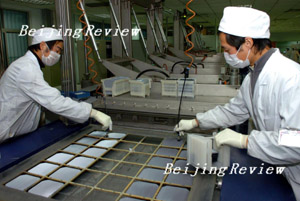|

Resources promulgated in 1995 presented goals, tasks and related policies for the period from 1996 to 2010. In September 1996, the World Solar Summit proposed pushing forward the "PV Project" in regions that do not have access to electricity. The Chinese Government gave a quick and active response, creating and implementing the Chinese Brightness Project, which aimed to provide electricity generated from solar energy and renewable resources to 23 million people in areas suffering from a shortage of power. The launch of this program immediately attracted attention from Europe, America and Japan. Many countries, international organizations and companies expressed their wish to cooperate on such programs to the Chinese Government, and some work is already underway.
"Although the cost of solar energy in China is six to eight times that of thermal power, in the past 10 years the PV industry still grew by 25 to 40 percent every year," said Zhao Yuwen of the China Solar Energy Society.
An increasing number of local governments are showing an interest in the PV industry. Tibet is one location where intensive solar energy construction has gone on. There are almost 400 solar power stations with a total capacity of 8 megawatt. Nearly half of Tibet's farmers and herdsmen are using PV-powered energy. Yu Heping, Deputy Director of Tibet's Development and Reform Commission, said that the industry is still in its infancy in Tibet compared with the huge potential of the region's renewable resources.
Experts from the National Development and Reform Commission who have been sent to Tibet for research have advised that the region should be established as a national model of "green" energy, which can help set a good example for other provinces and regions.
Officials of the Shanghai Municipal Government have also stressed the development of solar energy. Recently, Cui Rongqiang, Director of Shanghai Jiaotong University's Solar Energy Institute, wrote a project design report on constructing 100,000 solar energy roofs in Shanghai, which includes renovating 1.5 percent of Shanghai's flat roofs to solar-powered ones by 2015. However, only 15 percent of the solar energy collected can be converted to electricity, making the cost of solar power much higher than that of thermal energy.
The big difference in cost makes it fairly difficult to develop solar energy on a wide scale, but Cui is confident about the industry. "If 90 percent of PV cells can be produced by domestic manufacturers, the cost will be much lower. By 2015, the cost of PV power may be one third or one tenth of the present price."
Shadows loom
Thus far, there has been a rather unusual phenomenon in China's solar power industry: Over 90 percent of raw materials are imported and over 90 percent of products are exported.
Currently, photovoltaic cell companies widely use polycrystalline silicon as the raw material, which is refined from metallurgical-quality silicon that has a low grade of purity. The refining technology is still monopolized by a few large companies in developed countries. According to the Chinese Academy of Engineering, in 2005 China needed 3,800 tons of polycrystalline silicon, including 2,691 tons for the PV industry, but the country only produced 60 tons in 2004. Even if all the polycrystalline silicon produced by China are used in the PV industry, that would only account for 2.6 percent of the market's demand, which means all the rest has to be imported.
The material is also in great demand in the international market. A report on the solar energy industry by CLSA Asia-Pacific Markets pointed out that in the next two years, the biggest danger in the industry is a shortage of silicon. It added that if some companies cannot get enough silicon, profits would be reduced, which has happened already.
Yang, the United Securities analyst, said in 2003 every kilogram of silicon cost $24, but the price had risen to $60 at the beginning of 2005, and currently is $80. "I think this year the price will exceed $100," he said.
He noted that Tianwei Yingli left 60 percent of its photovoltaic cell production capacity unused for a period of time because of a shortage of silicon, and that Suntech will use $100 million of the funds from its IPO to buy the material.
Therefore, acquiring an adequate supply of high-purity silicon is an urgent matter for solar energy companies. Tianwei Yingli has invested in Sichuan Xinguang Co., which owns China's first and largest polycrystalline silicon production facility that can produce over 1,000 tons annually. It is expected to manufacture 1,260 tons this year.
Advanced Technology & Materials Co. Ltd., which is listed on the Shenzhen Stock Exchange, signed an agreement with German company Odersun in August 2004 to cooperate in jointly developing a new-type film solar cell, which will be put into mass production soon. The German Solar Energy Research Institute spent 10 years developing this low-cost solar cell technology, which uses copper foil as the raw material.
If this technology can reduce the cost to one quarter of the present price, the government would be capable of paying some subsidies to encourage wider use of photovoltaic cells. According to Advanced Technology executives, the company and Odersun have discussed building a joint venture with an initial design and manufacturing capacity of 3 megawatt per year, increasing to 10 megawatt in five years. As this is only an initial plan, the actual manufacturing capacity will be adjusted accordingly. However, some experts said this might indicate that China will soon be able to make its own solar cells.
| 